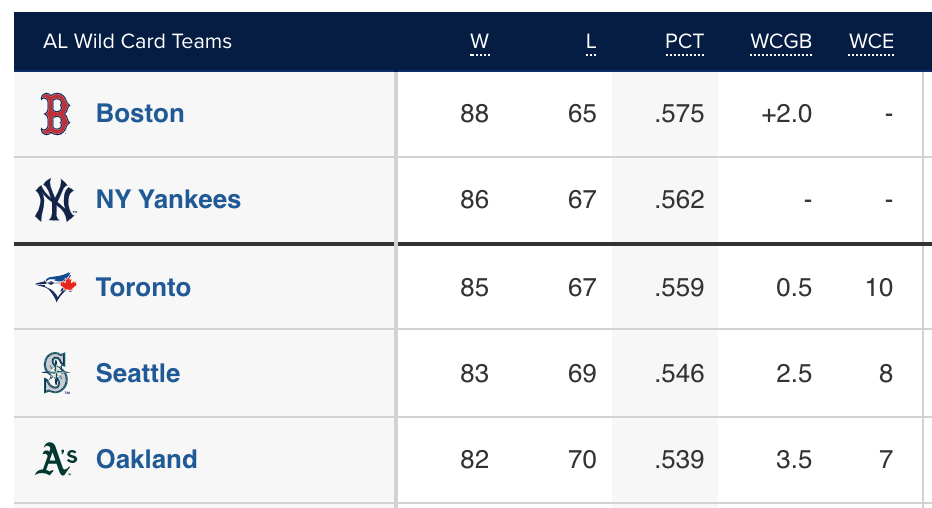Let's Go Streaking: Sox Win Seventh Straight, Get Set To Face Yankees
Plus: Notes on Chris Sale, home field advantage, the Wild Card, and every darn thing else
My wife loves ice cream. But she doesn’t want to eat ice cream. So she makes a compromise with herself. When she goes to the store, she buys ice cream, but she buys a flavor she doesn’t like. The problem (well, one of many) with this is, she buys vanilla and I like vanilla. It’s my favorite flavor! So, at night, after the kids are in bed and I’m thinking about what I should be writing for this newsletter, if there’s vanilla in the freezer, I’m pretty likely to have some. But, if there’s none in the freezer, I won’t eat any. Like most middle aged people, eating lots of ice cream isn’t a great idea. The answer, pretty clearly, is to not have any in the freezer. But my wife keeps buying it!
What does this have to do with the Red Sox? Not a ton if I’m honest, it’s just on my mind, but I’ll try to pull something from this wreckage: you can only deal with what’s in front of you at any given moment. If there’s vanilla, I’m eating it. Similarly, you can’t hold the Red Sox responsible for who they play. If it’s the Orioles and Mets, then it’s the Orioles and Mets. It’s not the Red Sox fault the Orioles are historically terrible and the Mets are extremely Mets.
Does that work? Maybe not, but it’s what I got. Also, what I got is this newsletter, which is free and fun, and hopefully an enjoyable way to follow the Boston Red Sox. So subscribe if you haven’t yet! And if you have, tell a friend!
The Win Streak Reaches Seven
Seven game winning streaks aren’t easy. The level of competition argument is true and real, but every year the Red Sox and just about every other team in baseball faces, by chance, a group of 10 or so games against bad competition. Rarely does it result in a long winning streak. It’s even rarer to pull that off twice in a season. But okay, how about three times? Why do I ask? Because this Red Sox team has done it! We’re in the midst of their third seven-game (or longer) winning streak of the 2021 season.
The First Streak: After losing the first three of the season at home against the Orioles (how weird was that?), the Red Sox won their next nine in a row sweeping Tampa and Minnesota, and winning the first three of a four game series in Minnesota.
The Second Streak: The Red Sox won eight in a row from June 25th through July 1 by buzzing through the Yankees and Royals, and winning the first of a three game set in Oakland.
The Third Streak: We’re in it right now! It started against the Mariners on September 14th as the Red Sox won the final two of a three game series in Seattle, and continued through two series, a three game sweep of the Orioles and a two game sweep of the Mets.
How rare is that? As usual, Alex Speier of the Boston Globe has your answer.

During this streak, the Red Sox have scored 59 runs for a per-game average of 8.4. To do that, they’ve hit .310/.388/.569 as a team, blasted 11 homers, and posted a wRC+ of 155, the best in baseball by a wide margin during that time.
As you’d expect, Red Sox pitching has been getting it done as well. The team ERA during this streak is 3.09, fifth best in baseball for the time period (September 14 through the 22nd). Somewhat surprisingly, Red Sox starters have a 4.18 ERA during the streak, but their (relative) mess has been cleaned up Boston’s pen which sports a 1.99 ERA.
As you can see, the Red Sox are doing this by blasting their way through opposing pitching staffs and getting a good amount of help from their bullpen. It won’t be this easy of course - there are no Orioles or Mets in the playoffs - but this is exactly the formula the Red Sox need to follow to have success in the post-season.
Hitting
I’ve written about the Red Sox offensive potential here frequently over the past few weeks. The upshot is that this team has more offensive firepower right now than they’ve had all season long. Yes, Jose Iglesias won’t continue with a 1.000 OPS (nor will he be available in the post-season), so some of this is coming back to earth, but on the whole this lineup is for real. They’re not as top-heavy as the Blue Jays lineup, but they might be deeper.
The Red Sox dropped 12 runs on the Mets without their starting second baseman (though Christian Arroyo did make an appearance later in the game once it was effectively already won) and without their starting first baseman, Bobby Dalbec, who has been one of the best hitters in baseball for almost two months now, and who routinely bats towards the back of the lineup.
Yes, the defense will suffer with one of Kyle Schwarber or JD Martinez in left field, but thems the breaks. While it’s not ideal and while team defense remains something that must be improved upon this off-season, that’s the way this team is constructed right now.
Will there be errors? Yes. Will there be defensive mistakes? Heck yes. Will there be moments you want to pull your hair out, stick a spork in your eye, and/or jump through a plate glass window? Likely simultaneously. But putting the best possible lineup out there, not skimping in any way on the team’s ability to score runs, remains the best possible way for this team to maximize their post-season run.
Homefield Is Important!
I touched on this a bit with Matt Collins of Over The Monster in my most recent Sox Outsider Podcast (link), but I think it’s worth mentioning here in more specifics. The Wild Card round isn’t really a round so much as it’s a single game. That game will be played at the home ballpark of the team with the better record. If the season ended today, the game would be played at Fenway Park. That’s something the Red Sox should work hard to hold on to.
Normally, I’d argue homefield isn’t much of an advantage, and lining up a team’s starters is far more impactful. But in this case, holding the game at Fenway is, for the Red Sox, pretty important beyond the normal reasons why home field is desirable.
Here are three reasons why.
This applies more strongly if the Red Sox are facing either Toronto (likely) or Tampa (extremely unlikely) rather than New York, but the Red Sox should strive like heck to avoid playing on turf. Both Toronto and Tampa play in ballparks with turf fields. The ball moves much more quickly on turf than it does on grass. This is a bad thing for an already leaky infield defense. Playing on a grass infield helps minimize this Red Sox weakness.
Playing at Fenway means the Green Monster will be in left and that means there’s a much smaller left field to patrol. This is good for a team that will likely feature a well below average defender in left field most of the time in either JD Martinez or Kyle Schwarber. Minimizing defensive requirements for left fielders helps the Red Sox far more than whichever team they end up playing.
The Red Sox often have a large home/road split when it comes to hitting, and this year is no exception. At home the Red Sox have a 118 wRC+ (100 is league average, 101 is one percent above, etc.), while on the road Boston has a 96 wRC+. In other words, they’re one of the best offenses in baseball at home, but a slightly below league average one on the road. Neither Toronto nor New York has anything close to that kind of split.
To sum up, playing the Wild Card game at Fenway helps the Red Sox infield, it helps them in left field, and helps them hit much better. Seems worth aiming for.
Chris Sale
I’ve kinda buried the lede here a bit because yesterday’s start by Chris Sale was one of the most important starts by a Red Sox pitcher this season. Sale’s last start was effective but kind of frightening as well. The issue was his velocity was way down. He was throwing 90, 89, 91 mph fastballs, and the separation in velocity between that and his changeup was pretty minimal, three or four miles-per-hour. Ideally, there would be a 10 mph difference between fastball and changeup, though Sale typically operates with a seven or eight miles-per-hour separation.
So how was Sale yesterday against the Mets? He was pretty good! Not great, not Vintage Chris Sale, but pretty good. And, it’s worth noting the results were again pretty impressive. He threw five innings with eight strikeouts, two walks, six hits, two runs, and no homers allowed against a Mets team that has a potent middle of the order, if nothing else. Sale’s fastball was notably faster than in his last start. Though there were a few in the low 90s, often he was around 94 mph, with some 95s sprinkled in (as well as 92s and 93s).
Sale doesn’t need to throw 97 to be successful, but it sure as heck doesn’t hurt, as he told Alex Speier of the Boston Globe.

I’m not concerned about Sale’s velocity reaching the upper 90s. If he can do that, great, fantastic, but he doesn’t have to reach that speed to be a great pitcher. That said, being successful against playoff-level offenses is going to be more difficult and require far more command if Sale is throwing 89/90 than if he’s throwing 94/95. To my eye, Sale doesn’t yet have the command he did pre-surgery, which makes rediscovering his velocity that much more important.
The Wild Card
The Red Sox, Yankees, and Rays are all off today (Thursday, September 23). The Blue Jays are in Minnesota while the Mariners and A’s play each other in Oakland. At the start of the day, here’s what the standings look like.
It’s a nice spot to be in, for sure.
Three against the Yankees in Fenway Park starts tomorrow with Nate Eovaldi facing Gerrit Cole. Should be some fun.
Speaking of fun, I hope you’ve enjoyed this newsletter. If so, please subscribe! If you’re already subscribed, please, kindly pass the newsletter on to a friend.
Thanks again for reading!





